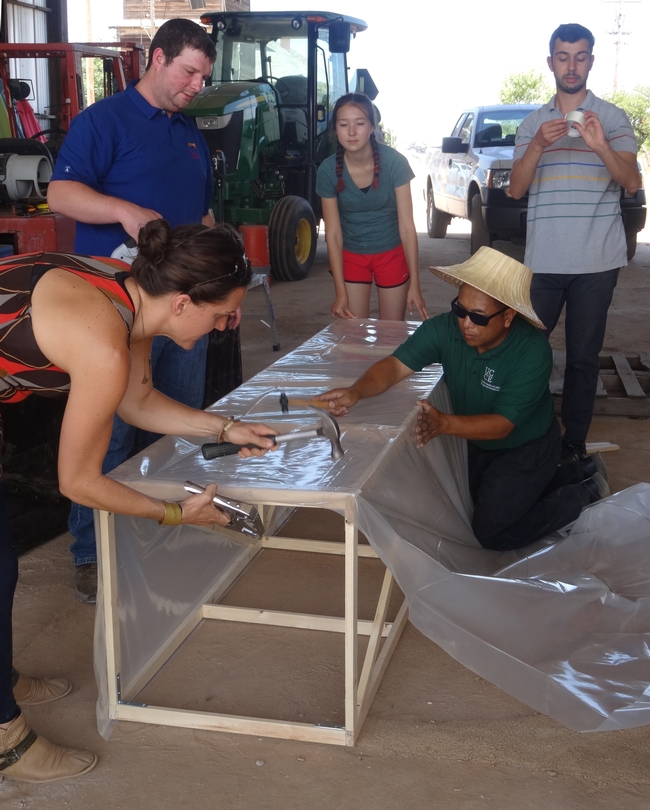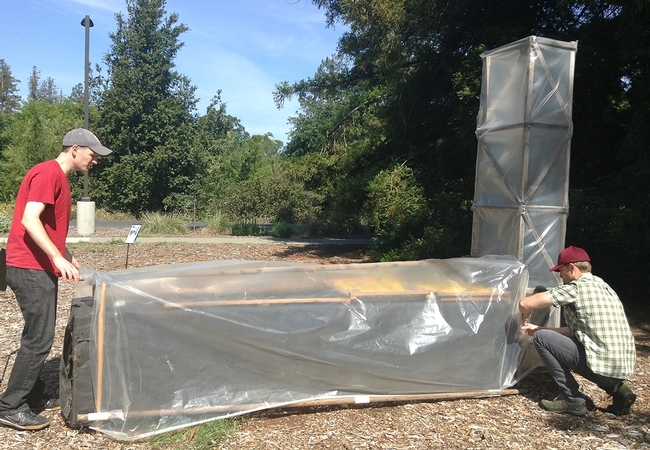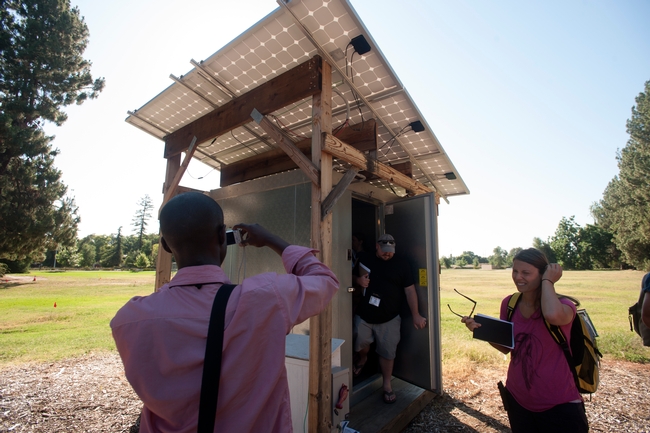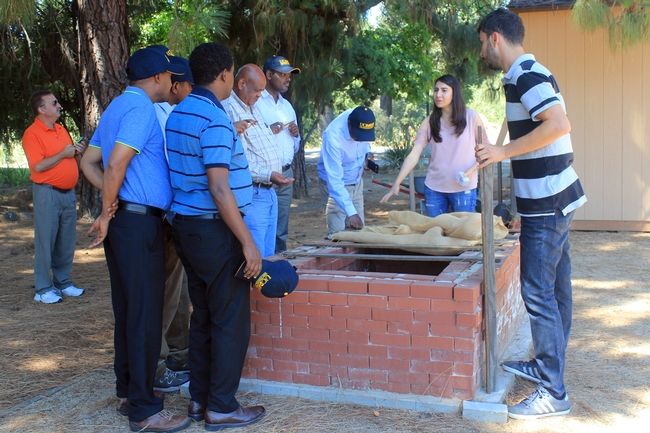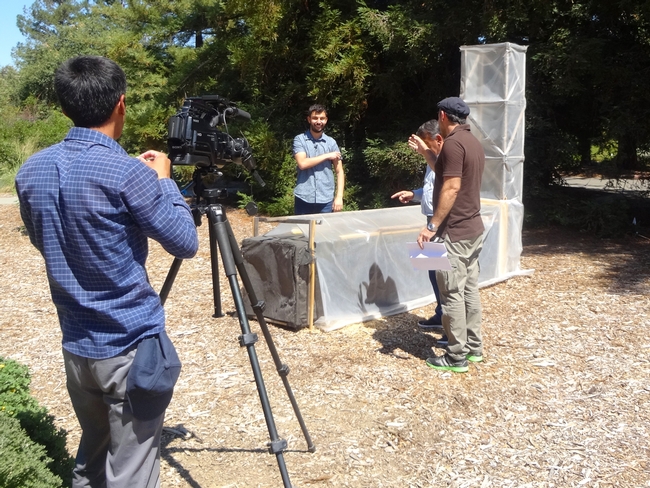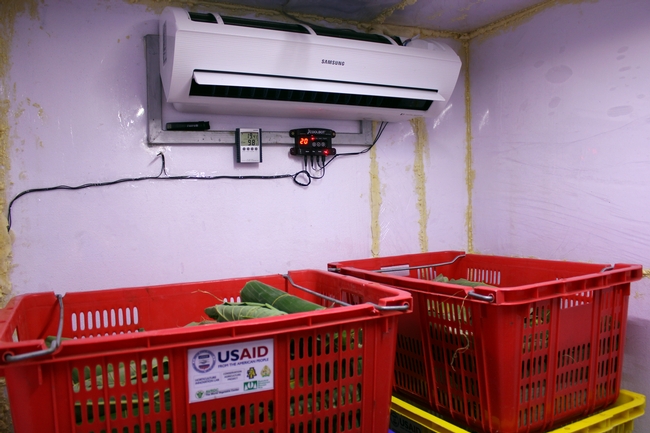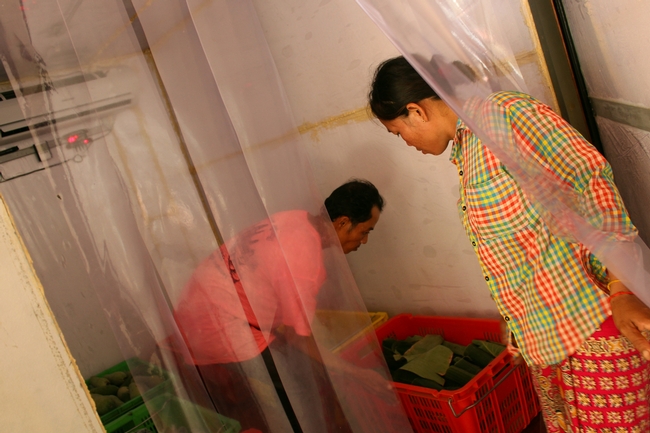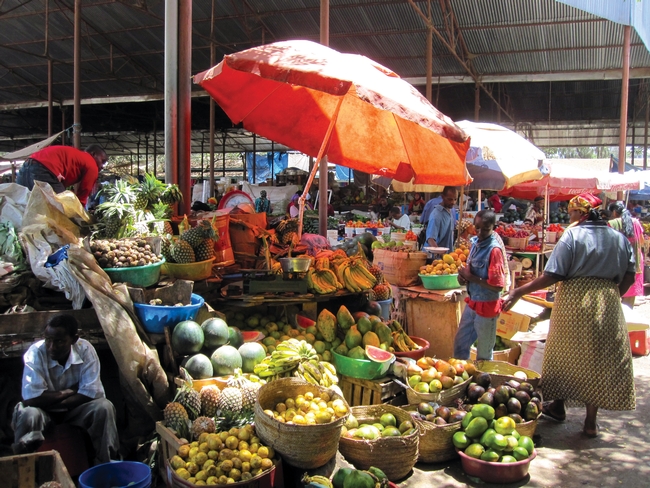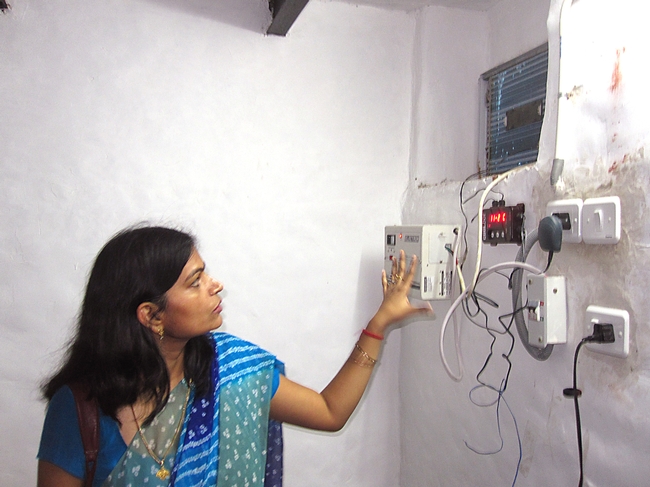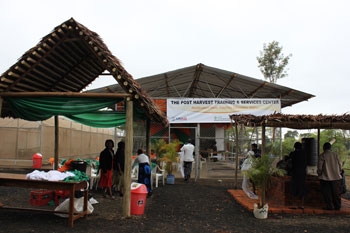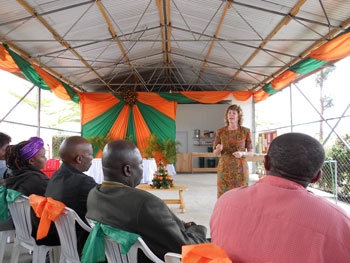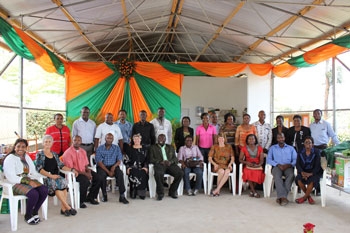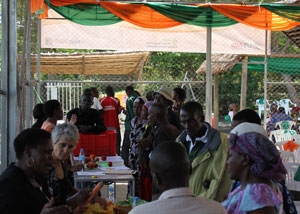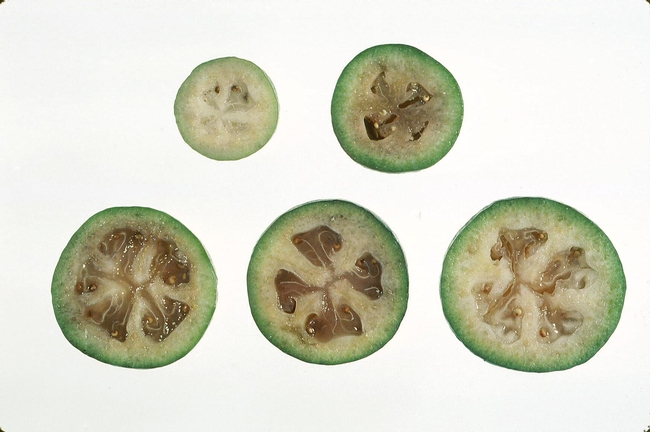Posts Tagged: Postharvest
Explore tools that UC researchers use with smallholder farmers around the world
Planted in a corner of the UC Davis campus is a display of technologies and vegetable crops that researchers with the Horticulture Innovation Lab have been using with farmers in Africa, Asia and Central America. Led by UC ANR's Elizabeth Mitcham in the UC Davis Department of Plant Sciences, this program harnesses the agricultural expertise of a network of U.S. university researchers to improve how farmers in developing countries grow fruits and vegetables.
More often than not, the learning goes both ways: Adapting solutions for farmers on another continent can spark ideas that might be useful back home too.
So while the Horticulture Innovation Lab's Demonstration Center was built to showcase international work to campus visitors, you wouldn't be the first to wonder, “Would this technology work on a California farm too?”
Recently a team from UC Cooperative Extension in Fresno County — led by Ruth Dahlquist-Willard, UC Cooperative Extension advisor for small farms in Fresno and Tulare counties — worked with the Horticulture Innovation Lab to learn how to build one of these technologies, to try out with local farmers.
The low-cost technology they built, called a “chimney solar dryer,” combines continuous air flow with solar heat to dry fresh produce more efficiently than a traditional solar dryer. It was designed by the innovative duo Michael Reid and Jim Thompson, both emeritus specialists with UC Cooperative Extension who have worked on multiple inventions with the Horticulture Innovation Lab. The chimney solar dryer is usually built with basic materials, such as plywood, dark plastic, clear plastic, and food-grade mesh. Read more about how the chimney solar dryer can help farmers add value to crop surplus (PDF).
Here is a quick look at a couple of other technologies that visitors can see at the demonstration center:
This solar-powered cold room uses a tool designed by an American farmer, called a CoolBot. In a well-insulated room, a CoolBot can trick a household air conditioner into bringing temperatures down low enough for cool storage of fresh produce. Cooling fruits and vegetables soon after harvest from the field can reduce postharvest losses and extend shelf life. So far teams with the Horticulture Innovation Lab have used the CoolBot with farmers in Tanzania, Zambia, Uganda, Thailand, Cambodia, Bangladesh, India and Honduras.
Read more about how this farmer's invention is reducing postharvest losses around the world.
The zero-energy cool chamber (known as ZECC) is a simple structure built from brick and sand that can help cool fresh produce, in conditions where evaporative cooling is effective. By regularly wetting the sand and brick, farmers or even marketers can keep the temperatures low and the humidity high for fresh produce such as leafy greens. Researchers with the Horticulture Innovation Lab have been testing what specific conditions — such as hot, arid climates with easy access to water — make this tool effective for farmers to use to cool their fresh fruits and vegetables.
More information about the ZECC is available from the UC Postharvest Technology Center.
Recent visits to the Horticulture Innovation Lab's demonstration center have come in many shapes and sizes — from people walking by who stopped to read some of the signs, to group activities planned in advance. Recent tours of the center have included a delegation of deans from agricultural colleges in Ethiopia, a television news crew from Tajikistan and high school students from California learning about innovation and human-centered design.
Next time you're on the UC Davis campus, consider dropping by the Horticulture Innovation Lab demonstration center. You can find it on the campus map, or contact the team for a more focused tour.
Maybe it will spark an innovative idea that you can use in your fields?
More information:
- More recent blog posts about the Horticulture Innovation Lab Demonstration Center
- Explore the African vegetables on display
- Learn more about the technologies on display
- Get updates from the Horticulture Innovation Lab's email newsletter
Led by UC Davis, the Horticulture Innovation Lab is funded by the U.S. Agency for International Development (USAID) as part of Feed the Future, the U.S. government's global hunger and food security initiative.
How one farmer’s invention is reducing postharvest losses around the world
In many developing countries, more than half of all fruits and vegetables are never eaten, but instead are lost, damaged or spoiled after harvest. These “postharvest” losses can mean that farmers need to sell their fresh produce as soon as it is harvested for whatever price they can get, before they lose the crops that represent investments of labor, water, and agricultural inputs. Improving how fruits and vegetables are handled after harvest can significantly prolong freshness — and cooling is key.
“The three most important aspects of postharvest handling are: temperature, temperature, temperature,” said Michael Reid, UC Cooperative Extension postharvest specialist who works with the Horticulture Innovation Lab at UC Davis. “In the developing world in particular, affordable cooling technology is mostly absent.”
Cooling can be expensive — even for American farmers
As a farmer in upstate New York, Ron Khosla knew this problem too well. His vegetable crop was spoiling too quickly, but he could not afford to buy a walk-in cooler for his small farm. So he invented a solution: a small electrical device he called a CoolBot that tricks an air conditioner into getting colder without freezing over, turning a well-insulated room into a cold room at lower costs than refrigeration.
“I was hoping for a cheap, DIY solution that I could maintain. But mostly I just needed to keep my leafy greens and strawberries cold,” Khosla said.
Khosla's CoolBot invention caught the eye of postharvest researchers, including Reid, who saw it in action on farms in California and decided to try using it in developing countries too.
CoolBot goes global with the Horticulture Innovation Lab
In one of his first projects with the Horticulture Innovation Lab (a program led by UC Davis with funding from the U.S. Agency for International Development), Reid partnered with agricultural scientists from Uganda, Honduras and India to test the CoolBot in their climates. The four scientists also tested different local materials as insulation for each of the cold rooms.
Since that first project, the Horticulture Innovation Lab has tested CoolBots for farmer cold storage in Tanzania, Zambia, Uganda, Thailand, Cambodia, Bangladesh, India and Honduras.
Jane Ambuko of the University of Nairobi is another Horticulture Innovation Lab partner who has worked with the CoolBot. She received a grant to pilot this technology with mango farmers for a program called the Kenya Feed the Future Innovation Engine. Her project was featured on an NTV Food Friday news segment about the CoolBot earlier this month.
“I see the CoolBot making a whole lot of difference,” Ambuko said during a TEDxNairobi speech. “But for it to make that desired difference we have to make it cost-effective and affordable for the smallholder farmers.”
Adapting, troubleshooting and scaling up
In many places, the most expensive part of a CoolBot-equipped cold room is the structure for the insulated room, but both Reid and Khosla expect foam building materials to become more widely available and affordable.
In the meantime, Khosla's small business has been growing — selling to not only farmers, but also florists, micro-brewers, and other artisanal food businesses. Now with six employees, the company has sold more than 27,500 CoolBots in 51 countries.
“I'm thrilled and so grateful to be a part of helping lots of people. Working with USAID has gotten us known in other countries, and I'm looking forward to the day when we have enough in-roads in India and Africa where we can work directly with farmers there,” Khosla said. “People didn't believe the CoolBots worked at first. But now we get the most amazing letters from people whose businesses have doubled or quadrupled. Good postharvest care makes such a difference. Once they try it, then they see.”
A previous version of this article appeared in the newsletter for Feed the Future, the U.S. government's global hunger and food security initiative, and also in the Horticulture Innovation Lab blog.
Event - Sustainable solutions and extending California's agricultural expertise to the world: The UC Global Food Initiative and UC Blum Centers will host a Global Food Summit on Sustainable Solutions, May 5-6 at UC Irvine. Elizabeth Mitcham, director of the Horticulture Innovation Lab and UC Cooperative Extension postharvest pomologist at UC Davis, will be speaking about technology transfer for horticulture-related technologies such as the CoolBot, seed drying beads, UC Davis-designed chimney solar dryer, pest-exclusion nets, and other tools the program adapts to the needs of farmers in developing countries. She will also be on a panel with two other UC Davis-based directors of Feed the Future Innovation Labs (UC Davis leads five Feed the Future Innovation Labs with funding from USAID — more than any other university). More info about this event.
Hot days, cool rooms, tasty vegetables
I'll admit that one of my favorite things to do on a hot day is to walk into an air-conditioned room. That burst of cool air in those first moments can be so refreshing.
It turns out I'm not alone — fruits and vegetables like to be cool on hot days too.
Controlling temperature helps regulate the aging process of a fruit, along with its water loss and microorganism growth. Storing fruits and vegetables at their lowest safe temperatures means they taste better and last longer.
To help us know the best ways to store fresh produce at home, the UC Davis Postharvest Technology Center offers a free PDF poster Storing Fresh Fruits and Vegetables for Better Taste, which includes tips for different fruits and vegetables, from avocado to watermelon.
Knowing the right temperature is only part of the battle for farmers, who are responsible for the first links in the cold chain. Getting produce out of the sun and cool for storage can be a big challenge — and an expensive one.
But a farmer in New York, Ron Khosla, answered this challenge with a tool that can help make cooling produce less expensive for small-scale farmers. He created the CoolBot, a micro-controller that turns a well-insulated room with a regular air conditioner into a commercial cool room for storing fruits and vegetables.
Just as small-scale American farmers struggle with affordable cooling, so do smallholder farmers elsewhere in the world. Researchers with the Horticulture Collaborative Research Support Program (Horticulture CRSP) decided to test the CoolBot device, first at the UC Davis Student Farm and then with farmers in India, Honduras and Uganda.
Indeed, the CoolBot-equipped rooms worked, and the program is building more in Bangladesh right now. But there is a catch: Farmers must have access to reliable grid electricity for a cool room like this to work. To address this problem, the CoolBot in Uganda was powered with solar photovoltaic cells, but that led to another set of challenges — expensive equipment and fear of theft.
So how do you effectively cool vegetables, hot from a field, without grid electricity? A solution that is low-cost, effective and off-grid has not been found yet. In an effort to uncover such a solution, Horticulture CRSP will soon be launching a technology design competition that asks that very question. Can you answer this challenge?
A postharvest program in sub-Saharan Africa promises long term benefits
In sub-Saharan Africa, postharvest losses of horticultural crops range from 30 percent to an astonishing 80 percent. Ongoing problems with food quality, safety and nutritional value are well documented. A number of past projects have identified appropriate actions, including implementing improvements in produce handling, training for regional agricultural leaders, capacity building, and small-scale infrastructure development, but these recommendations had not ever been integrated into local solutions. In 2011 the Horticulture CRSP awarded a pilot project to Diane Barrett, UC Cooperative Extension specialist in the Department of Food Science and Technology at UC Davis, Lisa Kitinoja of the World Food Logistics Organization, and Rob Shewfelt of the University of Georgia.
Since receiving funding from Horticulture CRSP, the initial focus has been developing and implementing a year-long, online training of 36 agricultural professionals in advanced postharvest technology, and building the first Postharvest Training and Services Center (PTSC) in Arusha, Tanzania, at the AVRDC – The World Vegetable Center’s Regional Center for Africa Campus.
Then, in early October 2012, when the Arusha PTSC first opened its doors, all 36 of the master trainers traveled to the center to complete the 11-day in-person segment of their training.
By mid-October the 36 “master trainers” officially “launched” the PTSC by participating in a series of training programs for local farmers in Arusha, before returning to their own countries with the designs and tools needed to launch new PTSCs and provide similar services and training. This project and all the PTSCs will provide access to training programs, adaptive research and demonstrations. These, along with the needed tools and supplies, will help to reduce postharvest losses and improve market access and incomes for small holders and women farmers throughout Africa.
“The launch of this pilot Postharvest Training and Services Center in Arusha is a great step in the direction of reducing food losses in developing countries," Kitinoja said.
She continues, "First, since we have trained 36 Africans as postharvest specialists from seven countries in sub-Saharan Africa, we now have a pool of skilled people to help us provide local training programs, demonstrations on improved postharvest practices, small-scale postharvest handling and processing technologies and innovative approaches to postharvest extension work, logistics and management of horticultural value chains. Already these young people have been implementing postharvest training activities in their own countries, and during 2011-12 they were able to reach more than 8,000 extension workers, leader farmers and horticultural entrepreneurs.
“Second, our model PTSC being piloted in Tanzania under the Horticultural CRSP postharvest extension for sub-Saharan Africa will serve as a hub for continuous activities in postharvest research, training of postharvest trainers and extension workers in East Africa, international short courses in postharvest technology, and training of local farmers in cost effective postharvest handling practices. Next week the first meeting will be held for the new Postharvest Working Group for Tanzanian researchers, and for 2013 we already have training programs scheduled on topics including improved practices for harvesting and field packing, cooling and cool storage for perishable crops, improved solar drying and packaging of dried horticultural crops.
“Third, the PTSC will provide local access for local farmers, farmers associations such as TAHA and regional extension workers to the missing postharvest tools, supplies, equipment and services that they will need in order to be able to implement the kind of improvements being promoted via the postharvest training programs being provided in Arusha. Most international projects provide education for potential beneficiaries, but very few projects provide the kind of follow-up that is needed to ensure that those who learn about new practices and technologies will actually get the chance to use them. In this case, a PTSC postharvest shop will allow the beneficiaries to invest in a wide range of options and the postharvest tools and supplies that it requires to be able to use a set of cost-effective improved practices and that leads to practical results and long-term changes, including reduced food losses and improved incomes.”
The Horticulture Collaborative Research Support Program (Horticulture CRSP) builds global partnerships for fruit and vegetable research to improve livelihoods in developing countries. The program is managed by UC Davis (directed by Beth Mitcham who also serves as the Postharvest Technology Center's Director) and funded by USAID. For more information, visit http://hortcrsp.ucdavis.edu.
Feijoa - You can eat that?
I first tasted a feijoa (fay-zho-uh, or pineapple guava) as a student here at UC Davis many years ago. A friend showed me her secret trees (south side of Wellman in Davis — tons on the ground right now!), and I was hooked. I didn’t think much of it at the time, other than thinking this is one of the best things I have ever eaten in my life. It tastes better than candy, and ripens right around Halloween - sweet! I had never seen or heard of a feijoa. You likely haven’t either, so I’m writing to introduce you.
First a little history. This subtropical plant originated in the higher altitude regions of central South America, but has since been introduced and grown commercially in Europe, California, New Zealand, South Africa and the area around southern Russia. In California, Sutter and Yuba counties were the hot spot for growing pineapple guavas in the late 1980s. Farmers in that area, who benefitted from the kiwi expansion a few years before, enthusiastically jumped into the feijoa business, however did not realize the same success.
According to Adel Kader, UC Cooperative Extension specialist emeritus, "the nurseries that provided the trees were not accurate in identifying the different variety of trees, and there was a large difference in the taste.”
So a farmer had no idea if he had a good tree or not. Additionally, judging fruit maturity is difficult since the fruits do not significantly change color as they ripen and drop to the ground when they’re mature. So the optimal picking strategy is by “touch picking” where if you touch a fruit and, if it comes off the plant, it’s ready to eat. Imagine doing that for a whole orchard.
Back to the present. I rediscovered feijoas after riding my bike down our street before the green waste pick-up a couple years ago and noticed about 30 feijoas in my neighbor’s pick-up pile! They didn’t know you could eat them. So, yes, I picked them out of the pile and introduced my neighbors to the deliciousness of the pineapple guava. And then I promptly went out and bought myself a tree to plant in my own yard.
Feijoas taste like taking the best elements of strawberry, guava and pineapple and mixing them together. They smell pleasantly sweet and flowery. To eat a feijoa, cut (or rip) it in half and scoop out the inside creamy white flesh (a little brownish color is fine to eat). Feijoas are a good source of vitamin C, fiber and potassium, and they even contain a little protein.
So, where can you find feijoas? Well, if you're in Davis, visit the south side of Wellman. Or, you can plant your own tree like I did (you can reference the Postharvest Technology Center’s Produce Fact Sheet for Feijoas here), or you can go to your local farmers market. It’s a short season, so this is the weekend to search them out. When you find them, Kader suggests you “look for a larger fruit with a slight give and a nice aroma.” You won’t be disappointed.


